

Wondering how to choose between English and French lavender? Here are a few key facts to make a decision you won’t regret!
Read also:
French lavender and English lavender are related, but they’re different species and they do have a few crucial differences.
Which is best? Which lavender deserves a spot in your garden ? Read on to tell them apart and discover which is best for you!
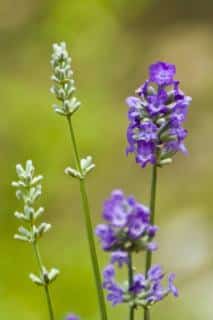 First and foremost, it’s important to know that what people call French lavender is either of two species.
First and foremost, it’s important to know that what people call French lavender is either of two species.
These are:
On the other hand, in the English language, English lavender is always Lavandula angustifolia.
Get to know them so you can choose the best variety for your garden and desires!
| _ | ||
| English lavender | French lavender (UK) | French lavender (USA) |
| Lavandula angustifolia | Lavandula stoechas | Lavandula dentata |
| Flower | ||
| no petals at the tip
long flower cluster, 1-3 in (2.5 to 8 cm) slightly cone-shaped, larger at the bottom than at the top usually, clearly marked levels or stages between rings of flowers usually, lavender color. Other cultivars range from white to pale pink, pale blue, or violet |
very long petals at the tip (4 or 6 of them)
shortest flower, 1 in (2.5 cm) olive-shaped, roundish rings of flowers tightly packed together usually, a deep violet, but there are blue, white and even red cultivars |
short but distinct petals at the tip
medium-length flower, 1-2 in (2.5 to 5 cm) elongated shape intermediate density of rings of flowers usually, pale lavender. some cultivars are white, yellow, deep violet |
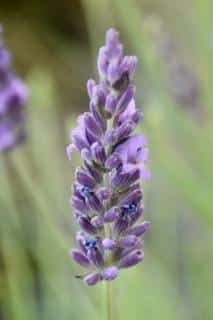 |
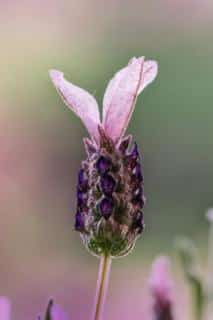 |
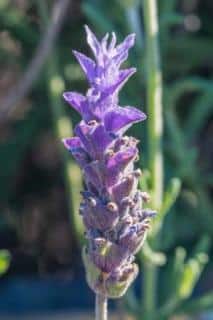 |
| Leafage | ||
| smooth edge, very narrow, often covered in powdery-white dust-like wax (not mildew!) giving it a silver-white sheen | smooth edge, very narrow, almost identical to those of English lavender but deeper green, less white covering | edged with squarish teeth, hence “dentata”, pale green leaves, thinly covered in protective wax. |
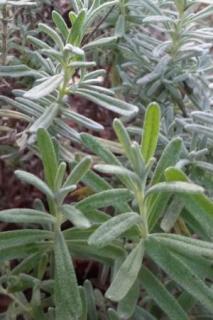 |
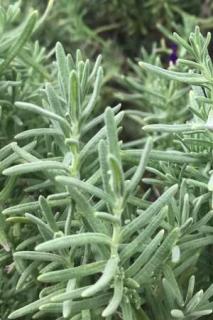 |
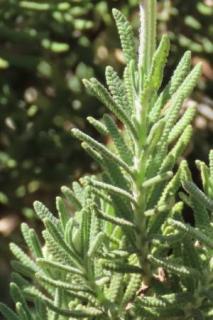 |
| Size | ||
| large usually 3 to 6 feet tall (1 to 2 m) |
medium usually 1 to 3 feet tall (30 cm to 1 m) |
small usually 8 to 24 inches (20 to 50 cm) |
| _ | ||
| English lavender | French lavender (UK) | French lavender (USA) |
| Lavandula angustifolia | Lavandula stoechas | Lavandula dentata |
| Climate and hardiness | ||
| dry, arid, low watering
cold-hardy -20°F or -30°C with good drainage perfect for outdoor growing & cultivation great for large outdoor containers |
dry, arid, low watering
frosty-hardy 0°F or -15°C with good drainage perfect for outdoor growing great for small outdoor containers |
fine with either dry or humid
half-hardy 23°F or -5°C with good drainage perfect for indoor growing, in pots |
| _ | ||
| English lavender | French lavender (UK) | French lavender (USA) |
| Lavandula angustifolia | Lavandula stoechas | Lavandula dentata |
| Fragrance, oil | ||
| softest but most appealing fragrance, high oil production, highest quality. Leafage similar to rosemary.
perfect for cooking, perfume, cosmetics, lavender wands and soaps |
strong and camphorus leafage, delicate-scented flowers, little oil in flowers
perfect for cosmetics, lavender pouches and wands, and soaps |
strong and camphorus leafage, more delicate-scented flowers, little oil in flowers
perfect for cosmetics, wands, pouches and soaps |
All three types are vibrant and lovely in the garden. Depending on the weather in your location, plant either of the French lavenders, or go for English lavender… or plant all three of them!
They’re all equally astounding, plant one of each in your flower bed. Their blooming will be staged over the whole season!
The sections of the chart are not labeled with the type of lavender. How do we know what section is for what plant?
Thanks Nic, I had mistakenly removed it in a previous edit. Fixed now!